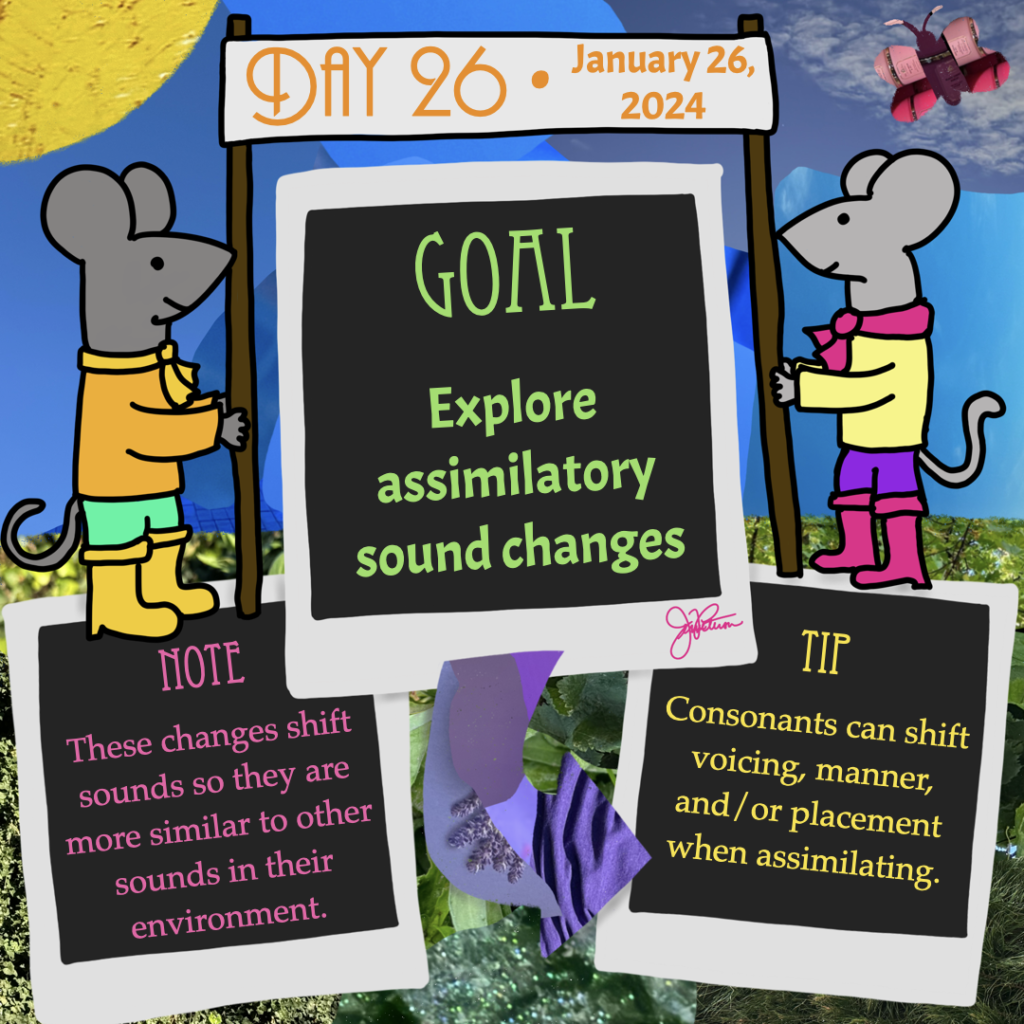
Goal: Explore assimilatory sound changes
Note: These changes shift sounds so they are more similar to other sounds in their environment.
Tip: Consonants can shift voicing, manner, and/or placement when assimilating.
Work focus: Learn/Brainstorm/Try
If you have completed all the prompts so far, you have at least 35 proto-forms in your language’s lexicon, and they will come in handy as we head into a new area. Everything you have done to this point has been to solidify the proto-language that provides a foundation for your language—it provides a constructed history for the forms that will take shape over the next months. Today shifts the focus to finding ways to evolve the proto-forms into a more modern stage of the language (it may not be the actual “modern” form, but it will be a later stage of the language).
One major ways that languages evolve over time is in their sounds. Throughout the next week, I will be prompting you to explore possible sound changes you may want to include for your language. There is no “right” amount of sound changes to use, and having more sound changes doesn’t make your language “better” or “stronger.” You just need to incorporate as many sound changes as necessary to get the language’s overall sound and feel where you want it for this project. That may mean incorporating five sound changes. That may mean incorporating twenty-five sound changes.
Use these days to explore options and research and see what other languages do to get inspired. I’ve broken down these introductory sound change days into basic types to help prompt you to look into some basic, common types of sound changes that occur in languages. The prompts are not meant to constrain you. If you are new to using the historical approach to conlanging, then you may want to start with fewer sound changes. You can always incorporate more later. Whatever you do, make sure you are documenting your decisions and noting all your brainstorms whenever ideas strike you. There’s nothing worse than having an amazing idea for a sound change only to forget it before you have a chance to incorporate it. (It also really stinks when you have a series of sound changes that you simply forget to apply and then have to go back through a lot of vocabulary to figure out which forms you missed…) I cannot understate the importance of documentation!
One common type of sound change is assimilation. Assimilation refers to any sound change where the features of one sound shift to become more similar to those in its immediate environment. I’m going to focus specifically on consonants and the common types of assimilatory sound changes that affect them.
Voicing assimilation
Voicing assimilation means shifting the voicing of one consonant to match another’s voicing, as in these example sound changes:
(example a) Unvoiced consonants become voiced when occurring before and/or after a voiced sound, such as *etga becoming edga.
(example b) Voiced consonants devoice when occurring before and/or after a voiceless sound, such as *etga becoming etka.
Notice that these examples demonstrate that assimilation can go in either direction: it can affect the sound occurring before another sound, as in example (a) where the *t becomes voiced before the *g, but it can also affect the sound occurring after another sound, as in example (b) where the *g becomes devoiced after the *t. You can decide how you want to apply these changes, restricting them so they only affect either consonants occurring before a particular type of sound or consonants occurring after a particular type of sound. In the case of voicing, sometimes languages require a sound to be “sandwiched” before it is affected. If that were the case, (a) would still come out as edga because both *e and *g are voiced, so the *t occurs between two voiced sounds and would become voiced. However, if (b) required a voiced sound to be surrounded by voiceless sounds before it devoiced, then the *g would not change.
Manner assimilation
Consonants can also change their manner to match or become more similar to another consonant’s manner, as in this example sound change:
(example c) Fricatives become stops when occurring before a stop: *eska becomes etka.
In this example sound change, notice that only the manner of *s shifts—voicing and placement remain the same when it becomes t.
Placement assimilation
A consonant’s place of articulation may also shift in particular environments, as in this example sound change.
(example d) A nasal consonant shifts its placement to match the placement of a consonant following it, such as *emta becoming enta.
While this example sound change is written to affect all nasal consonants, it could also be restricted to only affecting the alveolar nasal. In that case, *emta would remain emta, but *enpa would become empa.
A mix of the above
You can mix these types of changes together, making it so consonants shift in, say, voice and placement in particular environments. In fact, you may even have situations where full assimilation occurs, resulting in geminate consonants (or a doubled consonant pronunciation), such as *edka becoming ekka.
The goal for today is to research assimilation sound change options, note which ones you’re most interested in, and start trying them out on your proto-forms to see if you like what’s happening as they shift.
